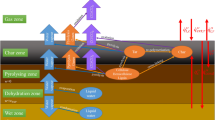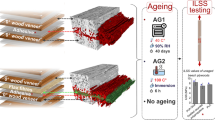Abstract
Timber mechanical properties assessment relies on grading methods that use non-destructive measurements in input, among which fibre orientation gives satisfactory outcomes. Several models exist in the literature to use fibre orientation data, based on either classical beam theory or finite element modelling. The present paper proposes to compare them for axial and bending loadings. To this end, the main approach was to use several artificial beams, for which fibre orientation was modelled around various knot positions in the tangential plane of wood. It is shown that beam theory modelling, despite considering the heterogeneity of moduli of elasticity in beam longitudinal direction, does not truly represent the actual deformations that can be depicted with finite element modelling. It results in significant differences in the accuracy of the assessment of the local modulus of elasticity, the finite element modelling being better. This finding was supported by experimental results obtained on laminated veneer lumber beams with a high knottiness. Additionally, this paper provides a comparison of different methods to compute localized moduli of elasticity that are typically used as strength predictors. The outcomes indicate that their behaviour depends on the loading type (axial or bending), the knot position in the beam, and the length of the sliding window across which they were computed. A localized bending modulus of elasticity (MoE) computed from the displacements, referred to as the 'apparent MoE', was defined in the objective to improve the accuracy of strength predictions.














Similar content being viewed by others
Data availability
The data that support the findings of this study are available from the corresponding author upon reasonable request.
Change history
22 April 2024
A Correction to this paper has been published: https://doi.org/10.1007/s00107-024-02077-z
References
Baño V, Arriaga F, Soilán A, Guaita M (2011) Prediction of bending load capacity of timber beams using a finite element method simulation of knots and grain deviation. Biosyst Eng 109:241–249. https://doi.org/10.1016/j.biosystemseng.2011.05.008
Briggert A, Olsson A, Oscarsson J (2020) Prediction of tensile strength of sawn timber: definitions and performance of indicating properties based on surface laser scanning and dynamic excitation. Mater Struct 53:54. https://doi.org/10.1617/s11527-020-01460-5
Burger N, Glos P (1995) Relationship of moduli of elasticity in tension and in bending of solid timber. In: Proceedings of CIB-W18 Meeting, Copenhagen, Denmark, Paper 28–5–2
CEA (2018) Cast3M [Computer software], Finite element code developed by the CEA, (French atomic energy commission). https://www-cast3m.cea.fr/
Drewett TA (2015) The growth and quality of UK-grown Douglas-fir. Thèse, Edinburgh Napier University
Duriot R (2021) Développement de produits LVL de douglas aux propriétés mécaniques optimisées par l’exploitation de la mesure en ligne de l’orientation des fibres lors du déroulage. These de doctorat, HESAM
Duriot R, Pot G, Girardon S, Denaud L (2021a) New perspectives for LVL manufacturing wood of heterogeneous quality—Part. 2: modeling and manufacturing of bending-optimized beams. Forests 12:1275. https://doi.org/10.3390/f12091275
Duriot R, Pot G, Girardon S, Roux B, Marcon B, Denaud L (2021b) New perspectives for LVL manufacturing wood of heterogeneous quality—Part. 1: Veneer mechanical grading based on online local wood fiber orientation measurement. Forests 12:1264. https://doi.org/10.3390/f12091264
Ehrhart T, Palma P, Schubert M, Steiger R, Frangi A (2022) Predicting the strength of European beech (Fagus sylvatica L.) boards using image-based local fibre direction data. Wood Sci Technol 56:123–146. https://doi.org/10.1007/s00226-021-01347-w
EN 338 (2016) Structural timber—strength classes. CEN European Committee for Standardization, Brussels
EN 408 (2012) Timber structures—structural timber and glued laminated timber—determination of some physical and mechanical properties. CEN European Committee for Standardization, Brussels
Foley C (2001) A three-dimensional paradigm of fiber orientation in timber. Wood Sci Technol 35:453–465. https://doi.org/10.1007/s002260100112
Frayssinhes R, Girardon S, Denaud L, Collet R (2020) Modeling the influence of knots on Douglas-Fir Veneer fiber orientation. Fibers 8:54. https://doi.org/10.3390/fib8090054
Fuchs MB (2016) The unit-load method. Structures and their analysis. Springer, Cham, pp 85–110. https://doi.org/10.1007/978-3-319-31081-7_6
Gil-Moreno D, Ridley-Ellis D, O’Ceallaigh C, Harte AM (2022) The relationship between bending and tension strength of Irish and UK spruce and pine. Eur J Wood Prod 80:585–596. https://doi.org/10.1007/s00107-022-01787-6
Goodman JR, Bodig J (1980) Tension behavior of wood: an anisotropic, inhomogeneous material: final report to the National Science Foundation: grant ENG 76-84421. Colorado State University, Dept. of Civil Engineering, Fort Collins, Colorado
Grazide C, Coureau J-L, Cointe A, Morel S (2018) Mechanical performance curves for the strength grading of maritime pine. Eur J Wood Prod 76:877–888. https://doi.org/10.1007/s00107-017-1241-4
Hanhijärvi A, Ranta-Maunus A (2008) Development of strength grading of timber using combined measurement techniques. Technical Report VTT Publications 686, VTT Technical Research Centre of Finland
Hankinson (1921) Investigation of crushing strength of spruce at varying angles of grain. Air Serv Inf Circ 3:16
Hu M, Olsson A, Johansson M, Oscarsson J (2018) Modelling local bending stiffness based on fibre orientation in sawn timber. Eur J Wood Prod 76:1605–1621. https://doi.org/10.1007/s00107-018-1348-2
Hu M, Olsson A, Hall S, Seifert T (2022) Fibre directions at a branch-stem junction in Norway spruce: a microscale investigation using X-ray computed tomography. Wood Sci Technol. https://doi.org/10.1007/s00226-021-01353-y
Huber JAJ, Broman O, Ekevad M, Oja J, Hansson L (2022) A method for generating finite element models of wood boards from X-ray computed tomography scans. Comput Struct 260:106702. https://doi.org/10.1016/j.compstruc.2021.106702
Kretschmann DE (2010) Wood handbook, chapter 05: mechanical properties of wood. For. Prod. Lab. Dep. Agric. For. Serv. Madison Wis. USA
Longuetaud F, Pot G, Mothe F, Barthelemy A, Decelle R, Delconte F, Ge X, Guillaume G, Mancini T, Ravoajanahary T, Butaud J-C, Collet R, Debled-Rennesson I, Marcon B, Ngo P, Roux B, Viguier J (2022) Traceability and quality assessment of Douglas fir (Pseudotsuga menziesii (Mirb.) Franco) logs: the TreeTrace_Douglas database. Ann For Sci. https://doi.org/10.1186/s13595-022-01163-7
Lukacevic M, Kandler G, Hu M, Olsson A, Füssl J (2019) A 3D model for knots and related fiber deviations in sawn timber for prediction of mechanical properties of boards. Mater Des 166:107617. https://doi.org/10.1016/j.matdes.2019.107617
Nyström J (2003) Automatic measurement of fiber orientation in softwoods by using the tracheid effect. Comput Electron Agric 41:91–99. https://doi.org/10.1016/S0168-1699(03)00045-0
Olsson A, Oscarsson J (2017) Strength grading on the basis of high resolution laser scanning and dynamic excitation: a full scale investigation of performance. Eur J Wood Prod 75:17–31. https://doi.org/10.1007/s00107-016-1102-6
Olsson A, Oscarsson J, Serrano E, Källsner B, Johansson M, Enquist B (2013) Prediction of timber bending strength and in-member cross-sectional stiffness variation on the basis of local wood fibre orientation. Eur J Wood Prod 71:319–333. https://doi.org/10.1007/s00107-013-0684-5
Olsson A, Pot G, Viguier J, Faydi Y, Oscarsson J (2018) Performance of strength grading methods based on fibre orientation and axial resonance frequency applied to Norway spruce (Picea abies L.), Douglas fir (Pseudotsuga menziesii (Mirb.) Franco) and European oak (Quercus petraea (Matt.) Liebl./Quercus robur L.). Ann For Sci 75:102. https://doi.org/10.1007/s13595-018-0781-z
Olsson A, Pot G, Viguier J, Hu M, Oscarsson J (2022) Performance of timber board models for prediction of local bending stiffness and strength—with application on douglas fir sawn timber. Wood Fiber Sci 54:226–245
Oscarsson J, Olsson A, Enquist B (2014) Localized modulus of elasticity in timber and its significance for the accuracy of machine strength grading. Wood Fiber Sci 46:489–501
Pollet C, Henin J-M, Hébert J, Jourez B (2017) Effect of growth rate on the physical and mechanical properties of Douglas-fir in western Europe. Can J For Res 47:1056–1065. https://doi.org/10.1139/cjfr-2016-0290
Rais A, Bacher M, Khaloian-Sarnaghi A, Zeilhofer M, Kovryga A, Fontanini F, Hilmers T, Westermayr M, Jacobs M, Pretzsch H, van de Kuilen J-W (2021) Local 3D fibre orientation for tensile strength prediction of European beech timber. Constr Build Mater 279:122527. https://doi.org/10.1016/j.conbuildmat.2021.122527
Saad K, Lengyel A (2022) Accurate finite element modelling of knots and related fibre deviations in structural timber. J King Saud Univ Eng Sci. https://doi.org/10.1016/j.jksues.2022.01.005
Simonaho S-P, Tolonen Y, Rouvinen J, Silvennoinen R (2003) Laser light scattering from wood samples soaked in water or in benzyl benzoate. Optik-Int J Light Electron Opt 114:445–448. https://doi.org/10.1078/0030-4026-00293
Steiger R, Arnold M (2009) Strength grading of Norway spruce structural timber: revisiting property relationships used in EN 338 classification system. Wood Sci Technol 43:259–278. https://doi.org/10.1007/s00226-008-0221-6
Viguier J (2015) Classement mécanique des bois de structure. Prise en compte des singularités dans la modélisation du comportement mécanique. [Strength grading of structural timber. Consideration of local singularities to predict mechanical properties]. PhD thesis, Université de Lorraine
Viguier J, Bourreau D, Bocquet J-F, Pot G, Bléron L, Lanvin J-D (2017) Modelling mechanical properties of spruce and Douglas fir timber by means of X-ray and grain angle measurements for strength grading purpose. Eur J Wood Prod 75:527–541. https://doi.org/10.1007/s00107-016-1149-4
Viguier J, Bourgeay C, Rohumaa A, Pot G, Denaud L (2018) An innovative method based on grain angle measurement to sort veneer and predict mechanical properties of beech laminated veneer lumber. Constr Build Mater 181:146–155. https://doi.org/10.1016/j.conbuildmat.2018.06.050
Funding
This study was funded by the region of Burgundy Franche‐Comté and the French National Research Agency (EffiQuAss project ANR‐21‐CE10‐0002‐01).
Author information
Authors and Affiliations
Contributions
Conceptualization: GP, RD, SG, JV, LD; Methodology: GP, RD, SG, JV, LD; Data Curation: GP, RD; Software: GP, RD, SG, JV; Formal analysis and investigation: GP, RD, SG; Writing - original draft preparation: GP, RD; Writing - review and editing: SG, JV, LD; Funding acquisition: GP, LD; Supervision: GP, LD, SG
Corresponding author
Ethics declarations
Conflict of interest
The authors have no relevant financial or non-financial interests to disclose.
Additional information
Publisher's Note
Springer Nature remains neutral with regard to jurisdictional claims in published maps and institutional affiliations.
The original online version of this article was revised due to correction in table 2.
Supplementary Information
Below is the link to the electronic supplementary material.
Rights and permissions
Springer Nature or its licensor (e.g. a society or other partner) holds exclusive rights to this article under a publishing agreement with the author(s) or other rightsholder(s); author self-archiving of the accepted manuscript version of this article is solely governed by the terms of such publishing agreement and applicable law.
About this article
Cite this article
Pot, G., Duriot, R., Girardon, S. et al. Comparison of classical beam theory and finite element modelling of timber from fibre orientation data according to knot position and loading type. Eur. J. Wood Prod. 82, 597–617 (2024). https://doi.org/10.1007/s00107-024-02055-5
Received:
Accepted:
Published:
Issue Date:
DOI: https://doi.org/10.1007/s00107-024-02055-5




